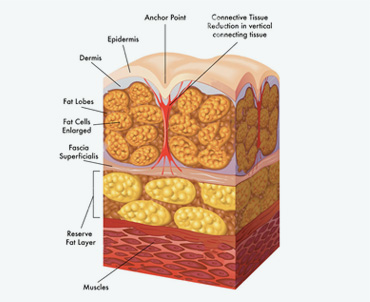
Radiofrequency
by Cellulite Institute editorial staff

Radiofrequency
Radiofrequency is a latest-generation treatment which helps to fight orange peel skin and localised adiposity.
Thanks to the electrothermal effects generated by electromagnetic waves, the treatment aims to:
- fight cellulite
- reduce localised adiposity
- eliminate water retention
The treatment requires a surgeon expert in aesthetics with experience, who has the best technology available and works in facilities appropriate for the treatment.
How does radiofrequency act?
Cellulite and localised adiposity are exposed to the electrothermal effects generated by electromagnetic waves, which act in a targeted and selective way on adipocytes and connective tissue.
The treatment acts specifically on the adipose cells that also cause fluid retention at the subcutaneous level.
It promotes:
- Metabolism at a localised level
- Disposal of deposited fluids
The heat generated is useful for:
- Production of new collagen
- Elimination of adipose cells
- Improved blood circulation
Radiofrequency for cellulite makes the skin firmer and more toned and acts on reducing the volume of treated areas.
The treatment involves the use of a device for:
- Heating and toning tissue
- Increasing blood flow
- Reducing cellulite and fat
The energy heats the skin without damaging it so that:
- Fat cells are broken down
- Collagen production is stimulated
- Tone and elasticity are improved
The treatment can also be used for:
- Excess fat on the belly, hips and thighs, and on double chins
- Toning loose skin after weight loss or pregnancy.
The treatment is safe and has short recovery times.
Radiofrequency: Who is the ideal candidate?
Radiofrequency treatments are typically requested by people who want to:
- Reshape the body
- Reduce fat deposits
- Improve the appearance of cellulite
Only the doctor expert in aesthetics can determine who is suitable for treatment.
Radiofrequency: How is treatment performed?
All radiofrequency treatments use handheld devices to:
- Fight cellulite
- Eliminate toxins
- Reduce fat deposits
- Drain excess fluids
- Increase collagen production for improving skin appearance
The treatment usually lasts from 30-90 minutes depending on the size of the area to be treated.
Before treatment a topical transducer and lubricant gel is applied to the skin.
After treatment, a soothing gel or cold compress can be applied to the skin.
Radiofrequency: How many applications are needed?
Depending on the device used, monthly maintenance sessions will be required.
After treatment
Most people return to normal activities immediately after treatment.
Radiofrequency. Risks and complications
The following are the most common side effects of treatment:
- Swelling
- Redness
- Bruising around the treated area, which usually disappears in a few days
Radiofrequency: Combinations with other treatments
Radiofrequency for cellulite can be combined with other treatments such as:
- Laser
- Deep-tissue massage
- Infrared light for the treatment of cellulite
What are the contraindications? The most common include:
- Pregnancy and breastfeeding
- Presence of a pacemaker
- Heart disease and cardiovascular diseases
- Taking anticoagulant medication
- The presence of skin infections: dermatosis, skin diseases such as psoriasis, dermatitis, etc.
- Autoimmune diseases
Only the expert doctor will be able to determine who is suitable for treatment without running risks.
Radiofrequency: Results
Radiofrequency for cellulite is used in the treatment of both deep and superficial cellulite.
The results are immediately visible, the skin is renewed and there are changes in both appearance and to the touch.
Moreover, the effects of radiofrequency are also long-lasting, especially if the doctor’s instructions are followed to the letter.
However, the best results are obtained with medical radiofrequency.
The main results are:
- Lifting effect, thanks to super-stimulation of collagen at various skin depths
- Drainage in areas affected by oedema, water retention and cellulite, thanks to the vascularisation effect
- Improved tissue tone
- Increased oxygenation of tissues



